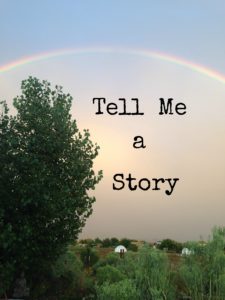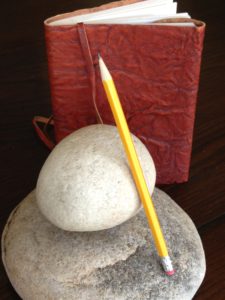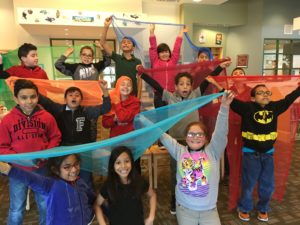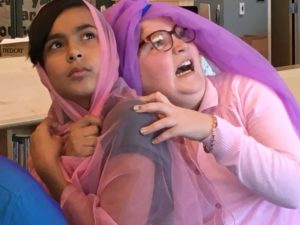Storytellers & Writers is aligned with Common Core State Standards, specifically addressing Language Arts Standards in Writing, Language, Reading, and Speaking & Listening. The program consists of three components: Reading, Writing, and Performance. Through these components, students learn the creative process, and they learn to be responsible and respectful of the freedom that is essential to creating.
Storytelling:
Reading Stories

Stories have been used for centuries to teach, to inspire, to heal, to make us laugh, and to help us make needed change and transformation. Stories represent our collective wisdom, told through many different cultural backdrops, offering us diverse voices to the incredibly complex human journey and pursuit to evolve and become “better”.
There are many types of stories, including fables and folk tales, and each culture colors them differently, making them uniquely their own. Though themes may be similar, and even story lines identical, stories go through a marvelous metamorphosis as each country shapes them in their own fashion.
Trickster tales are common around the world. In these tales a smaller creature, by using it’s intelligence and creativity, manages to outwit a larger, stronger, dominant creature, showing us that in a civilized world, might does not make right. Dilemma tales invite us to explore a problem from several different perspectives. Other stories teach by making fun of human foibles, or by setting up ridiculous circumstances to show us our blind spots or teach us the consequences of our actions.
Stories have the power to heal because they transport us to a safe place, a once-upon-a-time world far removed where we bring our hearts and our wounds without fear of judgement. Stories show us our humanity, our weaknesses as well as our strengths, and they remind us of the courage we have deep inside us to transform what no longer works.
♦ Reading the stories from their country as well as American folk tales, students learn to appreciate both cultures on a deeper level and develop a robust identity of who they are, where they came from, and where they now live.
♦ Stories used in the program are often written in both English and the students’ home language so that students get reading practice in both languages.
♦ Reading stories serves as preparation for the students writing and telling their own stories.
Writing:

Students are given a pre-assessment writing prompt to determine their current skill level and learning gaps, and a post-assessment prompt as one means to measure progress. The INCITE TO WRITE curriculum is used to address Common Core Language Arts Standards and bridge learning gaps. Students work on the following:
MECHANICS OF WRITING: PARAGRAPH BUILDING
Paragraphs are the building blocks for all genres of writing. Students strengthen their skills in writing paragraphs by learning to use their critical and creative thinking skills to generate writing ideas and get curious about the bigger picture. They learn how to stay in the inquiry and keep an open mind, ask open ended questions, create a topic sentence and main idea, elaborate and expand on a theme, add supporting sentences and details, stay on topic, and develop flow, sequence, and organization in their paragraphs.
GRAMMAR, DESCRIPTIVE LANGUAGE & VOCABULARY
Students strengthen their grammar skills, practicing how to write compound and complex sentences, use descriptive details and adjectives, and use proper transition words and subordinating conjunctions. Younger students receive an Explode the Code phonics workbook to help them with correct English pronunciation, spelling, and vocabulary building.
NARRATIVE WRITING

Using storytelling and drama-based strategies, students learn the organization of Narrative Writing, creating a Beginning (who and where), Middle (the Problem) and End (the Solution). They learn to quickly come up with story outlines and then expand on each section by asking questions. During this group activity, students learn to stay focused and think fast. After telling the “draft” of the story, students discuss how to strengthen the beginning, and how to strengthen plot development and resolution. Then they write their stories. Writing stories allows students to address their fears, their challenges, and their problems in a safe place. It allows them to try out different perspectives and bring humor to difficult situations. Students then work collaboratively in a group, brainstorming and using their imaginations to problem-solve and explore the creative process.
Performance:

One doesn’t need a Common Core Standard in Speaking to know how important it is for students to learn to speak confidently in front of a group. Fortunately for students, speaking, as well as listening, are required standards.
Right from the start of the Storytellers & Writers program, students practice vocalizing, speaking loudly in complete sentences and enunciating correctly in both English and their native language. Using games such as throwing a sound as if it were a ball, going up and down the scales making funny faces, and other typical Acting 101 activities, students quickly find out expressing themselves vocally is great fun.
Before they are even aware of it, students are “performing” stories as they learn to create the sections of Narrative Writing. Two students each take the part of the different sections of Narrative: the Who-Where section, the Problem section, and the Solution section, while other students ask them questions to help the storytellers fill out the details.
About halfway through the program, students are taught different storytelling techniques and styles. By now, creating organized stories has become a lot easier, and students are ready to take their creations to a new dimension. Using a minimum of props and brightly colored fabric, students add dialogue and even more details to make their story longer. They’re learning to collaborate, work in small groups and large, and appreciate the ideas, antics, and support of each member of the group. They’re also learning to problem solve, creating possible solutions to the problems they confront as students, and addressing challenges that even adults find difficult.

At some point, all of this wonderful creating must be shared. It’s time to perform. Performing is the component of the program that students love best. Even those who were shy at the beginning of the program are now confident and eager. Family members, teachers, sponsors, and the community are invited to attend. Because it is a dual language performance, it attracts a diverse audience, including many who have never before attended a theatre performance. All members of the audience, including non-English speaking members, are able to understand and enjoy the performance. With the culminating public performance, students have the opportunity to demonstrate their accomplishments and feel well rewarded for their work. Parents are able to see their kids be successful, and the kids know their parents are proud of them – both important ingredients that affect a child’s desire to succeed and ultimately graduate from high school.
